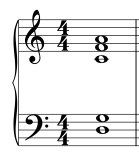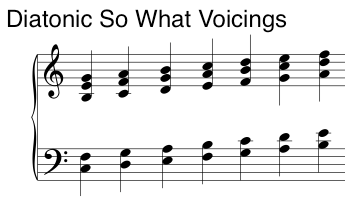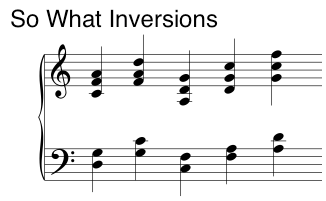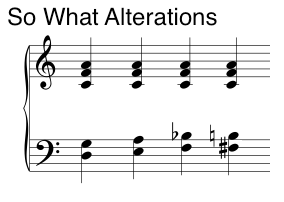Quartal Harmony
Up to this point, we have discussed building chords up in intervals of 3rds (tertian harmony). But it is also possible to build chords up in intervals of 4ths. This is called Quartal Harmony. The So What Chord is a specific type of Quartal Chord (we will discuss Quartal Chords in more detail in an upcoming lesson). The So What Chord Voicing is a classic and widely used Modern Jazz piano voicing. This chord voicing derives its name from the song So What from Mile Davis’ Kind of Blue album. In this song the pianist, Bill Evans, plays a particular chord voicing which has become known as the So What Chord.
Quartal chord voicings:
- Sound very modern;
- Are very ambiguous (there is no clear tonal centre [root note] and each voicing can be many different chords);
- Because they are ambiguous, they do not have the same need to resolve to any particular chord – they just float there as stand alone entities.
Chords built in 4ths are analysed in the same way as regular chords built in 3rds. We look at all the notes that comprise them and figure out an appropriate chord name. This is arguably unsuitable, because chords built in 4ths sound and function very differently to chords built in 3rds. But unfortunately, standard music theory is what everyone knows and uses.
So What Chord
The So What Chord is a two handed chord voicing made up of 5 notes. It is built out of three stacked Perfect 4ths with a Major 3rd on top. So, for example, the D So What Chord is:
- Left Hand: D-G
- Right Hand: C-F-A

Chord Ambiguity
Because of the way the So What Chord is constructed (out of 4ths rather than 3rds), it is rather ambiguous and can be numerous chords at once, depending on the context. Some of these chords are listed below.
| So What Chord | Possible Chords | Notes |
|---|---|---|
| D So What Chord D-G C-F-A | Dm11 | D F A C E G |
| B♭Maj13 | B♭ D F A C ( ) G | |
| E♭Maj13#11 | E♭ G B♭ D F A C | |
| F69 | F A C D G | |
| G9sus | G C D F A |
Because these chords are built in 4ths, they have a slightly Suspended Chord sound. This also means that they do not have the same need to resolve to another chord (like a G7 feels like it needs to resolve to CMaj7).
Chord Progressions
The So What Chord Voicing can be used in a standard ‘tonal’ chord progression (going around a Circle Progression or II-V-I) or a ‘modal’ chord progression (moving in steps). We will learn much more about tonal and modal harmony in future lessons.
Tonal Chord Progression
You can use the So What Chord in a II-V-I chord progression, as shown below.
| II-V-I in C | |||
|---|---|---|---|
| Basic Chord Progression | Dm7 | G7 | CMaj7 |
| Variation #1 | Dm11 | G9sus | CMaj13 |
| D So What Voicing | D So What Voicing | E So What Voicing | |
| D-G C-F-A | D-G C-F-A | E-A D-G-B | |
| Variation #2 | Dm11 | G9 | CMaj13#11 |
| D So What Voicing | Open | B So What Voicing | |
| D-G C-F-A | D-G B-F-A | B-E A-D-F# | |

Modal Chord Progression
Because the So What Chord Voicing is ambiguous and doesn’t need to resolve, you can move it around the piano however you like. Any chord can move to any other chord. You can create some really smooth and nice sounding progressions by moving the So What Chord up and down in steps (as is often done in Modal Jazz) or in small jumps. This can be done in two ways:
- Diatonic – Only using the notes within a key (Note: One of the 4ths in a diatonic key will be a ‘diminished 4th’ or tritone, like that between B and F in the key of C Major);
- Parallel Motion (Parallelism) – Keeping the true/classic So What shape.
| Root Note | Parallel (True So What) | Diatonic (in key of C Major) | Possible Chords (for Diatonic) |
|---|---|---|---|
| C | C-F B♭-E♭-G | C-F B-E-G | Gsus |
| D | D-G C-F-A | D-G C-F-A | Dm11 B♭Maj13 E♭Maj13#11 F69 G9sus |
| E | E-A D-G-B | E-A D-G-B | Em11 CMaj13 FMaj13#11 G69 A9sus |
| F | F-B♭ E♭-A♭-C | F-B E-A-C | G7sus FMaj7#11 |
| G | G-C F-B♭-D | G-C F-B-D | G7sus FMaj#11 |
| A | A-D G-C-E | A-D G-C-E | Am11 FMaj13 B♭Maj13#11 C69 D9sus |
| B | B-E A-D-F# | B-E A-D-F | G13 Bø7 Dm69 FMaj7#11 |

So What Inversions
Like any chord, So What Chords also have inversions. All of these inversions can be used if you need a different bass note or melody note on top. Notice that the 4th inversion of a So What chord is a standard Quartal Chord (which, again, we will discuss in an upcoming lesson).
| So What Chord Inversions | |
|---|---|
| Root Position | D-G C-F-A |
| 1st Inversion | G-C F-A-D |
| 2nd Inversion | C-F A-D-G |
| 3rd Inversion | F-A D-G-C |
| 4th Inversion (Quartal Voicing) | A-D G-C-F |

So What Alterations
You can also alter the interval between your left hand and right hand to create a new chord and a more dissonant sound. Below are a few examples of this.
| So What Chord | Notes | Possible Chord |
|---|---|---|
| Classic So What | D-G C-F-A | Dm11 |
| LH + 2 semitones | E-A C-F-A | Dm9 or FMaj7 |
| LH + 3 semitones | F-B♭ C-F-A | B♭Maj9 |
| LH + 4 semitones | F#-B C-F-A | ? |

Jazz Piano History
Quartal harmony was first used extensively by McCoy Tyner in the 1960’s. And because Quartal chords are a bit ambiguous, they are more conducive to Modal harmony (again, we will discuss Modal Jazz in a future lesson). Today, playing chords built in 3rds is considered a bit old-fashioned and simplistic. Instead, Modern Jazz Pianists prefer to play chord built in 4ths.
Have a Listen to
- So What ~ Miles Davis
- Peresina ~ McCoy Tyner
- Matrix ~ Chick Corea